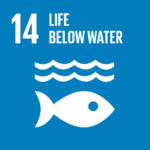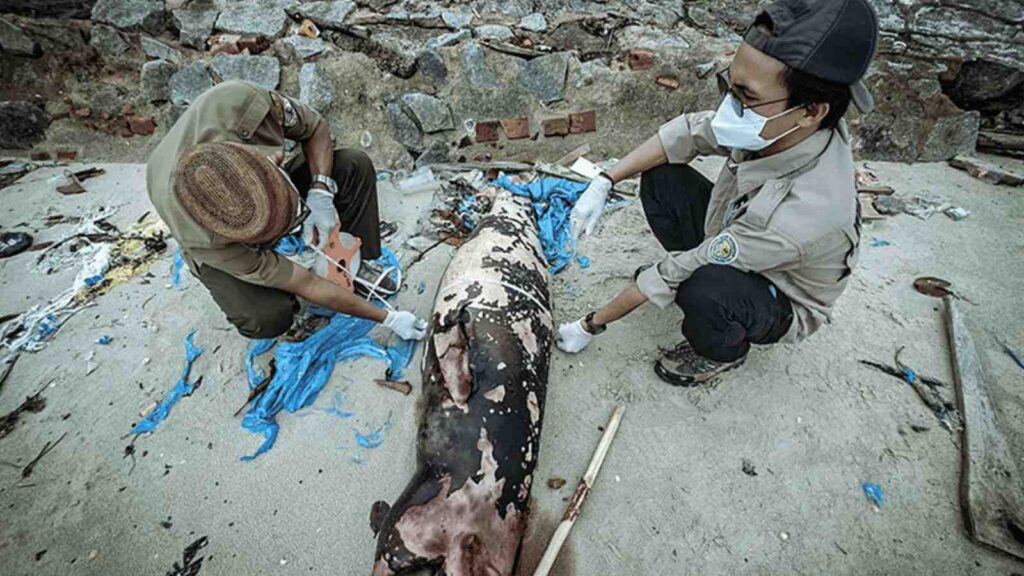Concerned locals attempted to rescue the freshwater dolphin by returning it to the sea, but unfortunately, the efforts were in vain, and the dolphin couldn’t survive the impact of plastic waste.
In a heart-wrenching incident, a rare species of freshwater dolphin, locally known as pesut, was found dead on the shore of Toboali beach. The carcass of the freshwater dolphin was discovered surrounded by heaps of garbage, an ominous sight that highlights the dire need for environmental action.
RELEVANT SUSTAINABLE GOALS



According to reports, concerned locals attempted to rescue the freshwater dolphin by returning it to the sea, but unfortunately, the efforts were in vain, and the freshwater dolphin couldn’t survive the impact of plastic waste.
The discovery has sparked a debate about the responsibility of our actions as individuals and as a community. “Who will be held accountable for this tragedy?” questioned Ikhwan, a concerned citizen who witnessed the incident.
The harmful impact of human waste on marine life and the environment has become increasingly apparent every day. It is imperative that the government takes preventive and reactive measures to prevent environmental pollution and enforce laws against polluters.
This incident is a sobering reminder that we must preserve and protect our marine biodiversity and environment. It is time to take action to reduce the usage of single-use plastics and ensure proper disposal of waste. We must act now to safeguard our oceanic biodiversity and environment before it is too late.
History repeats: Previous dolphin deaths on Bangka Island highlight urgent need for action
Sadly, this is not the first time such an incident has occurred on Bangka Island. In 2019, two dolphins were found dead. One was discovered on Terentang Beach in Bangka Tengah Regency, and the cause of death remains unknown. The other dolphin was found in Sungai Upang, Tanah Bawah Village, Bangka Regency, and had injuries to its head, suggesting intentional harm.
The death of this Irrawaddy Dolphin serves as a grim reminder of the dire consequences of environmental pollution and human activity on marine biodiversity. Immediate action is needed to prevent such incidents from happening again. As experts have recommended, genetic testing and further research are crucial in identifying the root cause of these tragic events and implementing necessary measures to protect these precious creatures. The fate of our marine life is in our hands, and we must act now before it’s too late.
Preserving Marine Mammals in Bangka Belitung: The Threats of Mining on Their Migration Routes
The Bangka Belitung province, being an island province, has 79 percent of its total area covered by the sea. This water is crucial as a habitat and migration route for marine turtles and mammals.
According to Sekar Mira, a marine mammal researcher at PRO-BRIN (National Research and Innovation Agency), “Marine mammals are a global migrating species. If the waters of Bangka Belitung are damaged, it will certainly disrupt the habitat and migration systems of marine mammals worldwide.”
Based on the 2020 Bangka Belitung Islands RZWP3K Regional Regulation, the migration route of turtles starts from the waters of Malaysia, the Riau Islands-Thousand Islands, the Anak Islands (Riau Islands), to the waters of Gelasa Island and Ayam Besar Island in East Belitung. Meanwhile, the waters designated as a migration zone for marine mammals are from Air Masin Island-Simpang Pesak waters, Gusunggurak Island-Berikat Cape, Tanjung Kelayang waters-Tanjung Berikat waters, and Kalimambang Island-Tanjung Berikat waters.
Sekar Mira also said that mining activities would undoubtedly put pressure on the existence of marine mammals, such as noise and waste. “The impact of mining pressure can be in the form of shifting the habitat of marine mammals, behavioral disturbances, health problems, and even death if it exceeds the tolerance threshold,” she added.
Jessix Amundian, the Director of Walhi Kepulauan Bangka Belitung, stated that there are several mining business permits [IUP] that overlap with the protected migration routes of sea turtles and marine mammals. “We note that along the 46.45 miles of the marine mammal migration route and 105.95 miles of the turtle migration route will disappear due to tin IUP in the region, so it must be revoked or removed,” she explained.
Lead image courtesy of RKE XVII BKSDA South Sumatra Resort. The BKSDA team, together with Alobi and a veterinarian, handled a dead river dolphin on the Toboali coast.


